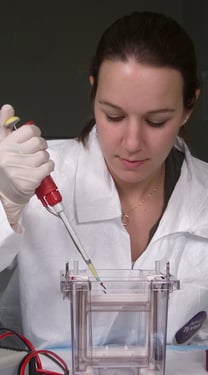
Gel electrophoresis is a simple, rapid and highly sensitive tool that can be used to separate proteins based on their physical properties (e.g. molecular weight and native charge or isoelectric point) prior to downstream detection or analysis. The separation of proteins by electrophoresis can be explained by the fact that charged molecules will travel through a gel matrix when an electrical current is applied. Proteins are commonly separated in this manner using polyacrylamide gel electrophoresis (PAGE) to identify individual proteins in complex samples or to examine multiple proteins within a single sample.
Choosing the Right PAGE for Your Application: Which Should You Use?
There are several types of PAGE that can be used as an analytical or purification tool for proteins (i.e. native or non-denaturing PAGE, denaturing or SDS-PAGE and 2D PAGE). However, since each of these methods provide different types of information about your protein of interest, you need to choose the most appropriate form for your application. How do you do this? Here are some things you may need to consider before making a decision.
Native or Non-Denaturing PAGE
By choosing the native or non-denaturing PAGE system, you can separate native proteins based on the size, shape and net charge of their native structure while preserving their function and activity.
Since the majority of proteins have a net negative charge at slightly basic pH, proteins with a higher negative charge density will migrate faster than those carrying a lower negative charge. In addition, smaller proteins will have a smaller frictional force as compared to larger proteins so they, too, will migrate faster. As a result, native PAGE can be used to separate proteins based on their mass and charge.
And since the samples are prepared in a non-denaturing and non-reducing buffer (e.g. SDS-free), the protein’s subunit interactions can be retained so you can use the information to analyze the protein’s quaternary structure. Some proteins are also able to preserve their enzymatic activity even after being subjected to native PAGE. These things make native gels the ideal choice if you want to determine the aggregation state of a protein, isolate enzymes and isozymes, and/or analyze protein complexes.
Note: In the native PAGE system, proteins can migrate toward either electrode so it may not be suitable for molecular weight determination.
Denaturing or SDS-PAGE
While the native PAGE system preserves the protein’s function and activity, the denaturing or SDS-PAGE system destroys the complex structure of the protein molecules so that the proteins will separate based solely on their mass when electrophoresed.
SDS-PAGE is commonly used for protein separation and analysis because of its simplicity, ease of use, resolving capability, and speed. In SDS-PAGE, the samples are heated at 100oC in the presence of excess anionic detergent (sodium dodecyl sulfate or SDS) and a reducing reagent (like dithiothreitol or DTT). The reducing agent breaks the disulfide bonds of proteins and destroys all tertiary or quaternary protein structures while SDS confers an overall net negative charge to the proteins. As a result, the previously complex tertiary protein molecules assume a linear, rod-like conformation and a net negative charge.
When all the protein molecules have similar charge-to-mass ratio, they can now be separated based solely on their size, enabling accurate determination of their molecular weight. Thus, proteins with lower molecular weights will migrate faster through the gel while proteins with higher molecular weights will lag behind.
This makes denaturing or SDS-PAGE suitable for estimating or confirming the molecular weight of a protein, isolating proteins based on size, and separating protein complexes into individual components. It can also be used for establishing the purity and integrity of a sample, in preparation for protein sequencing, and for post-electrophoresis applications such as Western blotting.





